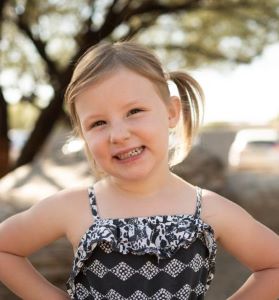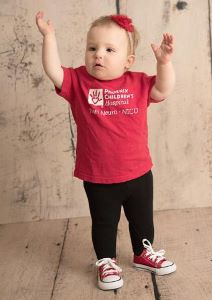- Center for Fetal and Neonatal Care
- Extracorporeal Membrane Oxygenation (ECMO)
- Neonatal Intensive Care Unit (NICU)
- Neonatology
As a Newborn Fought to Survive in the NICU, Her Mom Pumped Breastmilk

For 38 days, newborn Sage fought for survival in the neonatal intensive care unit (NICU) at Phoenix Children’s. Desperate to help sustain her first child’s life, her mother Kayla pumped breast milk throughout her daughter’s stay. The “liquid gold,” as one nurse described it, would be stored for Sage.
“For me, it felt like it was the one thing I could do for my baby at that time,” Kayla said. “I couldn't hold her or really touch her. So, pumping breastmilk was one of those things that kept me feeling like I had a purpose – like I was serving a greater good. I knew that when she finally got off life support, she was going to have her mom's goodness to eat.”
A Birth Emergency Leads to a Change of Plans
As Kayla and her husband David prepared for their first baby’s birth, they had everything planned. Kayla would give birth naturally, with no pain medications. The couple would travel to Prescott Valley, Kayla’s hometown, where an OB/GYN friend would deliver the baby. And once the couple brought the baby home, Kayla would be ready to be a breastfeeding mom.
“Breastfeeding was a huge part of my plan,” Kayla said. “I had done my research, and I had everything set to be a breastfeeding mom – 100 percent.”
Kayla and David’s plans changed drastically the night of Sage’s birth.
As Sage made her way through the birth canal, her left shoulder got stuck inside Kayla’s pelvis. This birth injury is called shoulder dystocia (or difficult labor or childbirth). It’s dangerous for both mom and baby, and at that point, it was too late for a cesarean section (C-section). And it was too late for Kayla to have pain medications.
Doctors and nurses immediately began lifesaving procedures, using every tool possible to deliver Sage. During the birth process, Sage aspirated meconium – a newborn’s first stool. This caused her lungs to fail, and she wasn’t breathing when she entered the world.
Once the medical team had Sage breathing and stabilized, she was air evacuated to the Phoenix Children’s NICU. She was put on a type of life-support called extracorporeal membrane oxygenation (ECMO), which pumps blood outside of the body. ECMO removes carbon dioxide from the blood and restores oxygen through a heart-lung machine. Additionally, Sage underwent hypothermia therapy, which cools down the body temperature, for the first 72 hours to help prevent brain injury. She was put on dialysis to support kidney function.
Stockpiling Liquid Gold
As Kayla began her own physical and emotional recovery from the birth, a nurse at the birthing center gave Kayla a breast pump. That allowed her to express the colostrum – the first form of breastmilk the body releases after birth. It’s rich in nutrients, antibodies and antioxidants.
“The nurse told me, ‘We need to get this liquid gold,’” Kayla recalled. “Sage was on life support for a week, and that meant she couldn’t get any breastmilk at that time – not even through a feeding tube. So, I pumped every couple of hours, each day, just trying to stockpile as much as I could for her.”
Several hours after Sage was sent to Phoenix Children’s, Kayla and David made the nearly two-hour drive to join her. They brought along the bag of colostrum preserved in ice packs.
Sage first received the colostrum through mouth swabs, and after her condition improved, the medical team began giving her breastmilk through a feeding tube.
“During this really stressful time when a baby is in the NICU, parents can feel powerless,” said neonatologist Deborah Tom, MD. “We have found that for moms that want to pump and provide breast milk, this helps them to feel empowered in helping their baby. They can partner with the medical team and essentially provide nutrition, which is like medicine for these babies in the NICU. It’s a way these families can feel like they have an active role in helping their babies heal.”
Even tiny amounts of colostrum swabbed in the baby’s mouth, as Sage received at first, provide benefits.
“Some studies have shown that providing oral care with breastmilk is beneficial for the immune system,” Dr. Tom said. “These babies are at high risk for infection, particularly those born prematurely because they're immunosuppressed. The colostrum helps protect them.”
Support for Breastfeeding and Pumping Moms
Whether a mom is breastfeeding her baby directly or pumping breastmilk to give her baby through a bottle or feeding tube, it can be difficult to produce milk during stressful times. Kayla turned to Phoenix Children’s lactation specialists, who support mothers wanting to breastfeed or supply breastmilk to their baby in the NICU. They gave her tips on foods she could eat to boost milk production – such as leafy green vegetables, carrots and beets – as well as little tricks that could help. For example, they recommended putting a small piece of clothing in the bed with Sage for a while and then putting that item on her shoulder while pumping to keep the baby’s scent close.
“Pumping is a very stressful thing, especially when you're just doing it full time,” Kayla said. “I was planning on breastfeeding – not solely pumping. So, I had to learn a whole different way of getting breast milk for my child than breastfeeding. It feels like all the trauma affected our breastfeeding journey as well because not only did we almost lose Sage, but there was a good chance they could have lost me, too.”
Some moms are unable or have chosen not to breastfeed for various reasons. Phoenix Children’s also has a donor breastmilk program to ensure that its sickest patients can benefit from this resource.
“The donor breastmilk is very safe and highly regulated,” Dr. Tom said. “The donors are tested, and the milk is pasteurized. Parents do need to sign a consent form for us to give it to their baby.”
Breastfeeding Challenges at Home
Kayla and David were thrilled to bring Sage home after nearly six weeks in the NICU. But the baby had swallowing difficulties because one of her vocal cords was paralyzed during ECMO surgery.
Even though Sage was able to latch onto the breast, she was not able to breastfeed because she would aspirate on the breastmilk, even though it is a thin liquid. Instead, it was safer to feed her thickened formula.
Sage’s follow-up care at Phoenix Children’s included working with the speech therapist to learn how to swallow. As a result of the shoulder dystocia, Sage had erbs palsey, a type of paralysis in the arm, so she had occupational therapy that started in the NICU and continued after she went home. A nephrologist (kidney specialist) also has followed her closely to watch for any problems resulting from her time on dialysis while on ECMO. If all goes well, she’ll no longer need that care once she reaches adulthood.

A Miracle Child
Now 6 years old, Sage is thriving after a rocky start to life.
“She’s our miracle child, for sure,” said Kayla.
An avid reader, Sage loves learning, reading and going to school. She’s a big sister now who loves helping her parents cook and bake. Sage also is learning to swim, and like her parents, she loves going to major league baseball games.
“If it wasn't for the amazing, talented and devoted doctors and nurses at Phoenix Children’s, we would not have our miracle baby,” Kayla said. “We’re so grateful they were there for us.”
